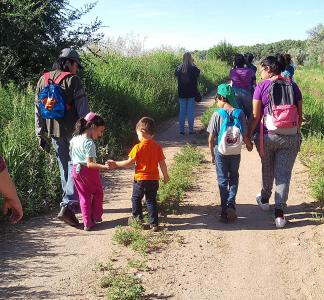People of color have been left out of nature. Equitable transit can help.

Better transit access fights historic wrongs.
Image made from assets by Mason Cummings, NPS.
Racist policies such as redlining forced communities of color to be 3x more likely than white communities to live in nature-deprived places.
Picture this: you wake up and see sunlight peeking in through the blinds. Your favorite weather app claims today will be a spectacular day. It’s time to go for a hike! But will it take you 30 minutes to get to the park—or 3 hours? It all depends on your access to transit.
Where is your nearest bus stop? Where do your friends live? Is there even a bus that can take you to that trailhead—and if not, how close can you get? How much time would it add to stop at a store for some extra supplies? What if you missed the bus? And most importantly, for your trip back, is the bus going to take you home too?
In 2021, our first-person, point-of-view accounts showcased some of the barriers millions across the country face accessing local parks or green spaces: people missed their bus, navigated a complex bus network, took hours to arrive and one even found their local green space to be a graveyard.
Across King County, Wash., one-quarter of residents, or about 500,000 people, cannot easily reach a public park, green space, or trail. Most of these residents are Black, Indigenous and people of color living in south King County.
People who rely on public transportation face a ton of obstacles just to get out to a trail. They may even decide it's not worth the trouble. This is not fair, and it's just one way the nature gap persists — Black, Indigenous and people of color; families with children (especially families of color with children); and low-income communities are most likely to be deprived of the benefits that nature provides because of the legacy of unjust policies like redlining, forced migration, and economic segregation. Additionally, the United States historically segregated and excluded people of color from public lands and other natural places.
In both urban and rural communities nationwide, lack of public transportation options is one of the primary barriers to accessing nature.
Historic racist policies led to further injustice
Due to unjust, racist policies such as redlining and economic segregation, communities of color are three times more likely than white communities to live in nature-deprived places.
Seventy-four percent of communities of color in the contiguous United States live in nature-deprived areas, compared with just 23 percent of white communities.
Studies show historically redlined areas are more likely to have fewer green spaces, and that formerly redlined areas could be 12.6 degrees Fahrenheit hotter than non-redlined ones, due to a lack of vital heat-reducing tree canopy.
People living in nature-deprived areas are also exposed to more pollution and are more likely to develop respiratory problems such as asthma.
Helping connect communities of color to nature is a critical climate and environmental justice issue. These populations face acute health problems from disproportionate pollution exposure. Recent studies show people of color are exposed to more pollution than white people from power plants, industry, traffic and other sources.

Historically redlined neighborhoods experienced the highest levels of pollution.
Guardian News Media Ltd under Open License terms.
How can we fix it?
Proposed legislation like the Transit to Trails Act strikes at this racial and economic inequity directly by awarding grants that provide transit opportunities from critically underserved communities to green spaces. (In case it wasn’t clear, it’s a great bill!)
Increasing transit connections to natural areas expands access to parks and open space for millions of vulnerable populations like those facing health issues and environmental burdens; families with low incomes; Black, Indigenous and people of color; and zero-vehicle households. Exposure to nature has also been linked to lowering blood pressure, decreasing the risk of heart disease and boosting the immune system. A 2019 study found that people who spend two hours outside per week report positive effects on their overall health and well-being compared to those who do not.
Trailhead Direct in King County is one such program addressing those barriers. It’s a transit service that takes people from the city to more than 150 miles of hiking trails. While this program has proven successful, there is still a great need to expand the number of bus stops in neighborhoods that lack public parks and greenspace, particularly in south King County.
So let’s make access to nature easier. Transit equity can close the nature gap and make it easier for all people to get to parks and other natural areas, while fighting injustice and improving the health and well-being of our communities.
If you want to learn about the difficulties in accessing nature via transit, try taking public transit to a trailhead near you! (And be sure to #RecreateResponsibly!) It's a great way to witness some of these problems first-hand, while also identifying close-by solutions. Take some pictures and videos and time how long it takes — then send an email to storybank@tws.org with your story. We’d love to hear from you!
New study maps transit-to-parks equity; shows south King County has greatest need and opportunity
Bob Wick
Report: Albuquerque park access lacking for vulnerable communities, but expanded transit could help
Cecilia Beltran, USFWS
Many communities lack access to parks and nature--Public transportation can help
Mason Cummings






